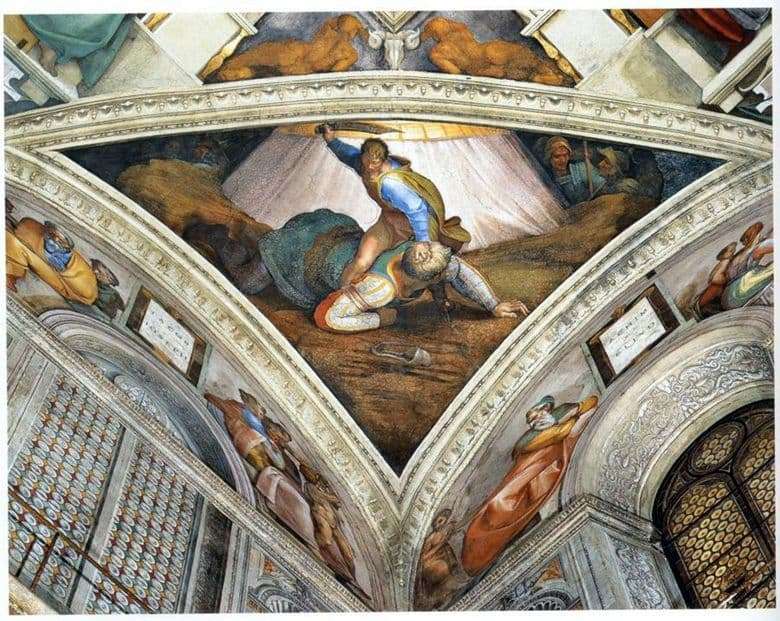|
In each corner of the Sistine Chapel ceiling is a triangular pendentive depicting Biblical stories associated with the salvation of Israel. These are four examples of the more violent ways the People of Israel were saved from their enemies and sinful ways. One illustrated the story of The Brazen Serpent as told in Numbers 21:4–9. Moses had rescued the Israelites from Egypt, but it was a long journey to the Promised Land. They began to complain and turn against God, saying, “Why have you brought us up out of Egypt to die in the wilderness? There is no bread! There is no water! And we detest this miserable food!” As punishment, God sent venomous snakes to attack and kill many of the Israelites. Michelangelo depicted the Israelites’ frantic battle with the serpents. In the background, he included an image of a bronze serpent on a pole. To save the Israelites’, God instructed Moses, “Make a snake and put it up on a pole; anyone who is bitten can look at it and live.” This spectacle, whilst violent, taught the Israelites to trust and obey Moses and the Lord. Another pendentive illustrates three scenes from the Book of Esther. Rather than telling the story chronologically from left to right, Michelangelo placed the final scene in the middle of the triangle. Esther was the wife of a Persian king who did not know that she came from a Jewish background. The king’s chief vizier, Haman the Agagite, hated the Jews and proposed a massacre to rid Persia of all people of Jewish descent. Haman particularly hated Esther’s cousin, Mordecai, who refused to bow down to the vizier. As a result, Haman persuaded the king to have Mordecai hanged. This part of the narrative is illustrated on the righthand side of the painting. Mordecai begged Esther to intervene by talking to the king, which she is seen doing on the lefthand side. Realising Haman’s plan would also result in Esther’s death, the king hanged Haman instead, as shown in the centre of the pendentive. Thus, the people of Israel were saved from death. Michelangelo’s painting of David and Goliath only illustrates one scene: Goliath’s death. David, an unlikely hero, defeated the giant warrior of the Philistine army with a slingshot, which ended the war between the Israelites and the Philistines. According to the Book of Samuel, chapter 17, after David knocked Goliath out, he “took hold of the Philistine’s sword and drew it from the sheath. After he killed him, he cut off his head with the sword.” Michelangelo’s interpretation is slightly different, with Goliath trying to scramble to his feet while David methodically carries out his task in the name of the Lord. David appears much stronger than the little shepherd boy written about in the Bible and more like the powerful king he later became. The fourth story comes from the apocryphal Book of Judith, which is not included in most Bibles. Judith was a Jewish woman living in Bethulia around 600 BC. At the time, the city was under attack by King Nebuchadnezzar’s army, led by the Assyrian general, Holofernes. To protect her city and the Israelites who lived there, Judith tricked her way into the enemy encampment where she seduced and intoxicated Holofernes. While he lay in a drunken stupor, Judith cut off his head. Michelangelo’s painting shows Judith and her maid carrying the severed head out of the tent where the headless body of Holofernes remains sprawled on the bed. Having lost their leader, the army dispersed, and the Israelites were saved. Part Four of Michelangelo’s Sistine Chapel, printed with permission from Hazel Stainer. To view the article in full, click here or visit www.hazelstainer.wordpress.com
1 Comment
3/31/2022 02:56:52 am
I am very impressed to see this beautiful art, which reflects the past when our forefathers used to live together, and they like to use old art in their homes and drawing rooms. I appreciate you who have highlighted the values of art in our living style.
Reply
Your comment will be posted after it is approved.
Leave a Reply. |
©Copyright
We are happy for you to use any material found here, however, please acknowledge the source: www.gantshillurc.co.uk AuthorRev'd Martin Wheadon Archives
June 2024
Categories
All
|




 RSS Feed
RSS Feed